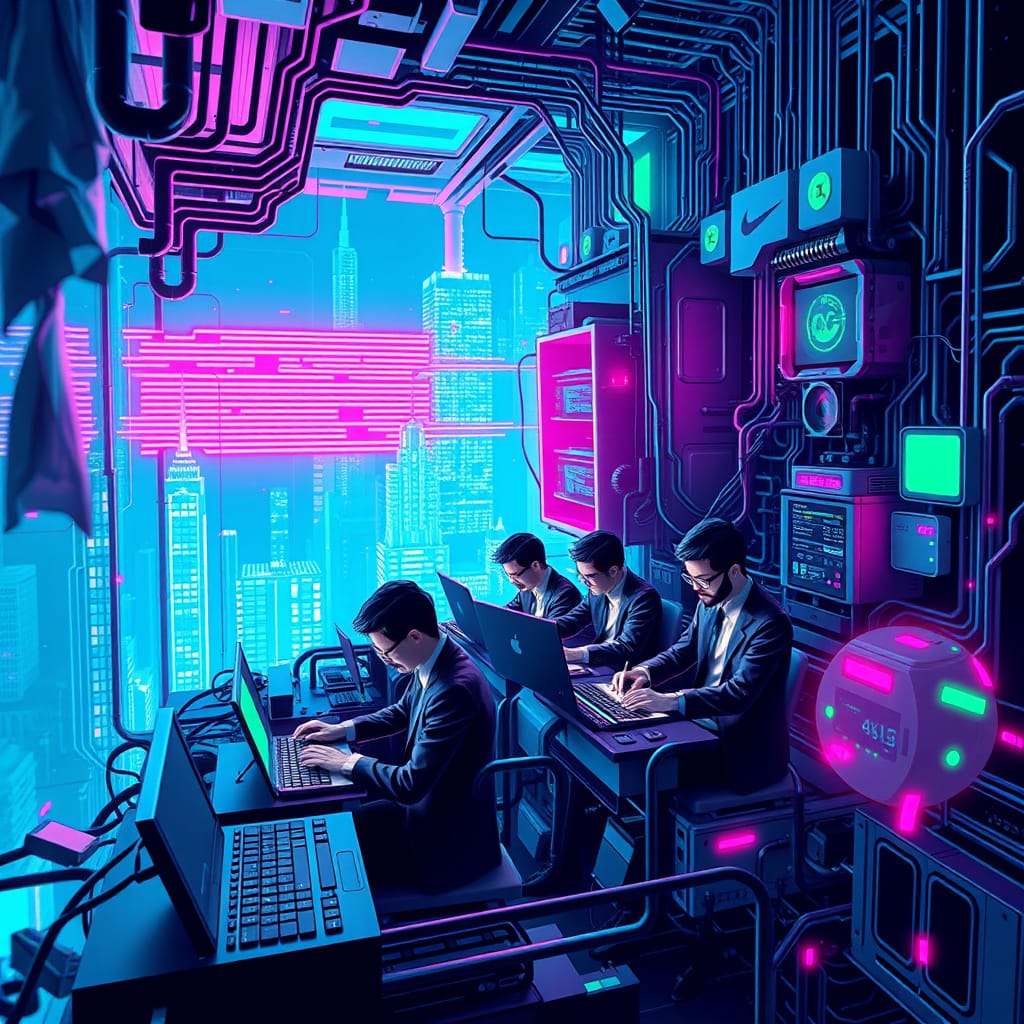In which we examine how one company’s ambitious promises of democratizing artificial intelligence became a masterclass in the ancient art of technological theater
The Rise of the Algorithmic Aristocracy
In the grand tradition of Silicon Valley’s most spectacular implosions, Builder AI emerged from the primordial soup of venture capital with all the fanfare of a digital messiah. Founded on the revolutionary premise that artificial intelligence could be democratized—packaged, productized, and delivered to the masses like a particularly sophisticated Italian pizza—the company promised to transform every small business owner into a tech mogul overnight.
The pitch was intoxicating in its simplicity: Why hire expensive software developers when our AI could build your mobile app faster than you could say “minimum viable product“? Why struggle with complex coding when our algorithms could translate your wildest entrepreneurial dreams into functioning software? It was the technological equivalent of promising that everyone could become Michelangelo simply by purchasing the right paintbrush.
Builder AI’s marketing materials read like love letters to human inadequacy. “No-code solutions for the code-averse,” they proclaimed. “AI-powered development for the software development-challenged.” Their target audience wasn’t just non-technical founders—it was anyone who had ever stared at a computer screen and wondered why making it do things required such arcane knowledge.
The company’s founder, Sachin Dev Duggal, the chief AI wizard, a charismatic figure who spoke fluent TED Talk and wore the uniform of disruption (black t-shirt, jeans, and the confident smile of someone who had never actually built anything themselves), became a fixture at tech conferences. His presentations were masterpieces of circular logic: AI would revolutionize software development because development needed revolutionizing, and Builder AI was revolutionary because it used AI.
The Algorithmic Alchemy
Behind the glossy marketing and venture capital enthusiasm lay Builder AI’s core innovation: a sophisticated system of templates, pre-built components, and what industry insiders generously termed “intelligent automation.” The AI, it turned out, was about as artificial as an American three-dollar bill and roughly as intelligent as a particularly dim chatbot having an existential crisis.
The company’s proprietary “AI engine” was, according to leaked internal documents, approximately 70% human contractors in developing nations (Indians with degrees from IIT), 20% existing open-source tools rebranded with proprietary names, and 10% actual machine learning—primarily used to optimize the company’s tea ordering system. The AI that promised to understand your business requirements and translate them into functional applications was, in reality, a sophisticated decision tree that would make a 1990s expert system blush with embarrassment.
Customers would input their requirements through an intuitive interface that asked questions like “What kind of app do you want?” and “How many users will it have?” The AI would then perform its magic, which consisted of selecting from approximately 47 pre-built templates and customizing the color scheme. The resulting applications had all the uniqueness of mass-produced IKEA furniture and roughly the same level of craftsmanship.
The company’s technical team, a collection of genuinely talented Indian engineers who had been hired under the impression they would be building the future, found themselves instead maintaining an elaborate Rube Goldberg machine of marketing promises and technical compromises. Internal Slack channels, later leaked to industry publications, revealed a culture of cognitive dissonance that would have made Orwell proud.
The Venture Capital Validation Cycle
Builder AI’s funding rounds read like a case study in the venture capital echo chamber. Series A investors, impressed by the company’s “revolutionary approach to democratizing development,” led a $15 million round based primarily on a Microsoft PowerPoint presentation and a demo that worked exactly once, under carefully controlled conditions, with the engineering team standing by with duct tape and prayer.
The Series B round, a staggering $45 million, was secured after the company demonstrated “significant traction” in the form of 10,000 registered users—a number that sounded impressive until one realized that 9,847 of them had never actually built anything, and the remaining 153 had created applications that could charitably be described as “functional” in the same way that a bicycle with square wheels is technically a vehicle.
Venture capitalists, caught in the familiar trap of not wanting to admit they didn’t understand the technology they were funding, doubled down with enthusiasm that bordered on religious fervor. “Builder AI represents the future of software development,” proclaimed one prominent investor, apparently unaware that the future he was describing looked suspiciously like the past, but with more marketing.
The company’s valuation reached $200 million, a figure that seemed reasonable only when compared to other AI companies whose primary artificial intelligence was their ability to artificially inflate their intelligence. Builder AI had successfully monetized the gap between what people wanted technology to do and what technology could actually do—a gap roughly the size of the US’s Grand Canyon and twice as profitable.
The Great Unraveling
The beginning of the end came, as it often does in Silicon Valley, with a single disgruntled customer who possessed two dangerous qualities: technical expertise and a Twitter (Now X) account. Sarah Chen, a former software engineer turned bakery owner, had used Builder AI to create what she hoped would be a simple ordering system for her business. What she received instead was an app that occasionally worked, frequently crashed, and once somehow ordered 500 pounds of flour to be delivered to her competitor.
Chen’s detailed technical analysis of her Builder AI application, posted as a Twitter (Now X) thread that went viral faster than a cat video, revealed the uncomfortable truth: there was no AI. The emperor’s new algorithms were, in fact, a sophisticated costume made of marketing copy and venture capital enthusiasm, worn by a very human, very fallible system of templates and offshore contractors.
The thread, which began with the innocuous observation “Something seems off about my Builder AI app,” quickly evolved into a forensic examination of the company’s entire technical stack. Chen discovered that her “AI-generated” app was identical to seventeen other apps in the Builder AI ecosystem, differing only in color scheme and the name of the business. The AI that had supposedly learned her unique requirements had apparently learned them from a template called “Generic_Restaurant_App_v2.3.”
The revelation sparked a feeding frenzy among tech journalists, who had been waiting for exactly this kind of story like vultures circling a particularly promising roadkill. Within 48 hours, Builder AI found itself the subject of investigative pieces that revealed the full extent of the company’s creative interpretation of artificial intelligence.
The Human Intelligence Behind the Artificial Intelligence
Perhaps the most damning revelation came from a whistleblower known only as “DarkWeb2.0,” who leaked internal communications revealing the true nature of Builder AI’s operations. The company’s “AI development team” consisted primarily of contractors in Eastern Europe and some in India who would receive customer requirements and manually assemble apps from a library of pre-built components.
The process was about as artificial as a Kardashian reality TV show and roughly as intelligent as the average social media comment section. Customers would submit their requirements to the AI, which would forward them to human software developers who would spend anywhere from two to six weeks manually creating what the customer had been told would be generated instantly by machine learning algorithms.
The company had developed an elaborate system of status updates and progress reports designed to maintain the illusion of AI-powered development. Customers would receive notifications like “AI is analyzing your requirements” (translation: we’re reading your email 10 times to understand the english), “Neural networks are optimizing your user interface” (translation: we’re googling the color wheel and picking colors), and “Machine learning algorithms are generating your backend” (translation: we’re copying and pasting code from Stack Overflow).
The most sophisticated aspect of Builder AI’s operation wasn’t its artificial intelligence—it was its artificial artificial intelligence. The company had created a convincing simulation of AI development that was more complex and resource-intensive than simply hiring developers and being honest about it.
The Domino Effect of Disillusionment
Builder AI’s collapse sent shockwaves through the AI startup ecosystem, creating what industry observers dubbed “the authenticity crisis.” Suddenly, venture capitalists who had been throwing money at anything with “AI” in its name began asking uncomfortable questions like “What does your AI actually do?” and “Can you show us the algorithms?”
The ripple effects were immediate and brutal. Scale AI’s CEO was spotted at a Washington D.C. steakhouse, reportedly having a three-hour dinner with US President Trump’s team, leading to speculation about the prophylactic power of political donations. Elizabeth Holmes, the disgraced founder of Theranos, was seen taking copious notes during a prison library session, apparently working on what sources described as “a comprehensive guide to technological theater.”
Other AI companies found themselves scrambling to prove their legitimacy, leading to a wave of technical demonstrations that ranged from genuinely impressive to hilariously transparent. One company, when pressed to demonstrate their natural language processing capabilities, presented a chatbot that could only respond with variations of “That’s an interesting question” and “Let me get back to you on that.”
The venture capital community, faced with the uncomfortable realization that they had been funding elaborate performance art rather than technological innovation, began implementing new due diligence procedures. These included revolutionary concepts like “actually testing the technology” and “asking to see the source code.”
The Lessons of Artificial Artificiality
Builder AI’s spectacular failure illuminated several uncomfortable truths about the current state of artificial intelligence and the venture capital ecosystem that funds it. First, the gap between AI marketing promises and AI technical reality remains roughly the size of the observable universe. Second, the venture capital community’s understanding of AI technology is often inversely proportional to their enthusiasm for funding it.
Perhaps most importantly, Builder AI demonstrated that in the current AI gold rush, the most successful companies aren’t necessarily those with the best technology—they’re those with the best stories about their technology. The company succeeded not because it built superior artificial intelligence, but because it built a superior narrative about artificial intelligence.
The irony is that Builder AI’s actual service—connecting non-technical entrepreneurs with offshore developers through a streamlined interface—was genuinely useful. Stripped of its AI pretensions, the company was providing a legitimate service that solved real problems for real customers. The tragedy is that this wasn’t enough; in Silicon Valley’s current climate, being useful isn’t sufficient if you’re not also revolutionary.
The Builder AI saga serves as a cautionary tale about the dangers of technological theater and the importance of distinguishing between innovation and performance. In an industry where perception often becomes reality, the line between artificial intelligence and artificial artificiality has become dangerously thin.
As the dust settles on Builder AI’s collapse, the broader AI industry faces a moment of reckoning. The emperor’s new algorithms have been revealed as elaborate costumes, and the question now is whether the industry will learn from this exposure or simply design better costumes.
What’s your take on the Builder AI debacle? Have you encountered other “AI” companies that seem suspiciously human? Share your experiences with technological theater in the comments below—we’d love to hear your stories of artificial artificiality.
Enjoyed this dose of uncomfortable truth? This article is just one layer of the onion.
My new book, “The Subtle Art of Not Giving a Prompt,” is the definitive survival manual for the AI age. It’s a guide to thriving in a world of intelligent machines by first admitting everything you fear is wrong (and probably your fault).
If you want to stop panicking about AI and start using it as a tool for your own liberation, this is the book you need. Or you can listen to the audiobook for free on YouTube.
>> Get your copy now (eBook & Paperback available) <<





GIPHY App Key not set. Please check settings